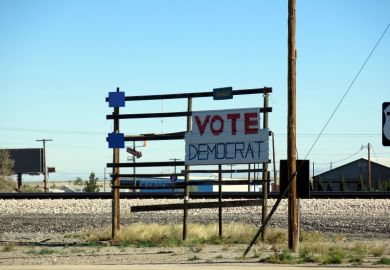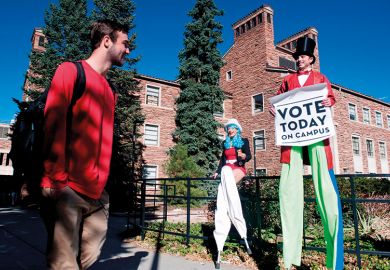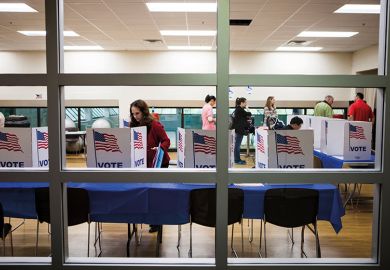Several hundred campuses and other residential communities housing US college students are split by gerrymandering techniques, diluting their voting power in ways that may violate federal law, Tufts University researchers have found.
The findings were assembled by the Institute for Democracy and Higher Education at Tufts just ahead of the state-by-state redistricting that follows the decennial US census, as a warning that students can expect determined pushback after breaking out of their historically low voting rates during the Trump administration.
Its analysis showed hundreds of US campuses and surrounding communities – virtually all in Republican-controlled states – with the tell-tale jagged lines of voting district boundaries that have been drawn with computerised precision to dilute the voting power of the local residents.
“That’s pretty obvious” as a sign of gerrymandering, said Nancy Thomas, the institute’s director, describing the contorted lines on maps of legislative districts, “and we have all these cases of it”. Altogether the analysis found 289 cases involving congressional districts around campuses, and 390 involving state legislative districts.
Gerrymandering is not necessarily illegal in the US, because courts have allowed state lawmakers to act with some measure of political intent when they create unusual district boundaries. But federal law prohibits such tactics if they disadvantage particular groups of people who enjoy specific constitutional protections, based on factors such as race and age.
Because of that, Dr Thomas said, the types of gerrymandering that the Tufts researchers found around many US college campuses could be subject to legal challenge in courts. The Tufts data could be useful evidence in such efforts.
The US conducts a formal census of its population every 10 years. From that information, seating distributions are reallocated for state legislatures and the US House of Representatives, which also determines state power in presidential elections. That process is now under way for the 2022 elections, at the same time as Republicans in the aftermath of Mr Trump’s defeat have been making concerted efforts to restrict voting rights in several states, feeling their supporters are better positioned to overcome whatever procedural hurdles they impose.
That politically charged atmosphere raises the importance of understanding and affirming gerrymandering that disadvantages college students, Dr Thomas said. The US has nearly 20 million college students, and the Tufts report noted that they are relatively young, female and racially diverse, making them an important target for suppression efforts by conservative strategists.
And student turnout in the past three national elections – above 50 per cent in the two presidential elections and about 40 per cent in the 2018 congressional vote – has helped challenge the idea of students as a low-value group that is more likely to protest than actually cast a vote.
For conservatives hoping to dampen that surge, gerrymandering looms as a critical tool. A 2019 Harvard University study analysed state legislative elections in seven states in 2012 where Republican-controlled legislatures redrew districts after the previous census to maximise the waste of Democratic votes. Candidates from the two major parties in those seven states received about 16.5 million votes each, but Republicans won 73 seats to 34 for Democrats, it said.
That type of great imbalance risks being amplified with the results of the 2020 census, Dr Thomas said, because 19 states – all controlled by Republican legislatures – have already passed laws this year restricting voting rights.
Actions aimed at limiting student votes also appear to have a major racial component, the Tufts analysis found. Its data showed that districts around college campuses were more likely to have been gerrymandered if their communities were bigger and if they had larger minority student populations.
Andrew Taramykin, a sophomore at the University of Florida, told a briefing arranged by the Tufts research team that he knows of fellow students in Gainesville who live across the street from each other and yet belong to different legislative districts.
“When we’re split into multiple districts,” said Mr Taramykin, a member of the Campus Vote Project advocacy group, “we’re only further outnumbered by the communities that surround us, which often tend to be much older, much whiter, and usually have very different political interests than what we have.”
College students won a key voting rights victory in 1979 when the US Supreme Court ruled that they could cast ballots in their campus communities.
Mr Taramykin, however, said he chooses to vote in his hometown in Florida, where the relatively close balance between the two main political parties makes his participation “more politically valuable” than it is in Gainesville, where he spends most of his time.
Dr Thomas said she saw no equivalency between that kind of strategic decision and the political manipulation represented by gerrymandering. “I want voters to pick their politicians, not the politicians to pick their voters,” she said.
Register to continue
Why register?
- Registration is free and only takes a moment
- Once registered, you can read 3 articles a month
- Sign up for our newsletter
Subscribe
Or subscribe for unlimited access to:
- Unlimited access to news, views, insights & reviews
- Digital editions
- Digital access to THE’s university and college rankings analysis
Already registered or a current subscriber?








